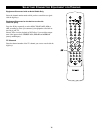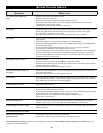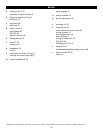
37
WARNING Concerning Stationary Images on the TV Screen :
Do not leave stationary or “letterbox” images on screen for extended periods of time.This can cause
uneven picture-tube aging.
Normal use of the TV should involve the showing of pictures that contain constantly moving and changing images that fill the
screen. Be careful not to leave nonmoving images on screen for extended periods of time or to display the same images on screen
too frequently, because subtle ghost images can be left on the picture tubes. Avoid showing the same stationary images more than
15 percent of your total viewing in any one week. Sources of stationary images may be DVD discs, laser discs, video games, CD-i
discs, videotapes, digital television boxes, broadcast channels, cable channels, satellite channels, and others. Here are some exam-
ples of stationary images (this is not an all-inclusive list; you may encounter others in your viewing) :
• DVD menus—listings of DVD disc content
•“Letterbox” black borders—black bars shown along the edges of the picture when a widescreen (16:9) movie is played on TV
• Video-game images and scoreboards
• Television station logos—present a problem if they are bright and stationary; moving or low-contrast graphics are less likely to
cause uneven aging of the picture tube
• Stock-market tickers—presented at the bottom of the TV screen
• Shopping channel logos and pricing displays—bright and shown constantly or repeatedly in the same location on the TV
screen.
All picture tubes age with use, with their light output diminishing over time. But by maintaining normal use—mixing television
picture types—you will create conditions for the tubes to age at an even rate. The result will be a TV picture that is evenly bright
over the entire screen.
P
LACEMENT OF THE TV
• See page 4.
C
LEANING
• To avoid possible shock hazard, be sure the TV is unplugged from the electrical outlet before cleaning.
• Regularly dust the TV with a dry, nonscratching duster to keep the TV clean.
• When cleaning the TV, take care not to scratch or damage the screen surface. Avoid wearing jewelry or using anything abrasive.
Do not use household cleaners. Wipe the front screen with a clean cloth dampened with water. Use even, easy, vertical strokes
when cleaning.
• Gently wipe the cabinet surfaces with a clean cloth or sponge dampened in a solution of cool, clear water and a mild soap or
detergent. Use a clean, dry cloth to dry the wiped surfaces.
• Occasionally vacuum the ventilation holes or slots in the back cover of the set.
• Never use thinners, insecticide sprays, or other chemicals on or near the cabinet, as they might cause permanent marring of the
cabinet finish.
T
IPS
• Do not shift or move the set around when it is switched on. Unevenness in colour in some parts of the screen may occur.
E
ND-OF-LIFE DISPOSAL OF THE TV
Philips is paying much attention to making its products environmentally friendly. Your new TV contains materials that can be recy-
cled and reused. Specialised companies can dismantle your discarded TV at the end of its life, concentrating on the reusable materi-
als and minimising the amount of materials to be disposed. Please be sure to dispose of your old TV according to local regulations.
D
ISPOSAL OF EXHAUSTED BATTERIES
The batteries supplied do not contain the heavy metals mercury and cadmium. Nevertheless, in many countries exhausted batteries
may not be disposed of with your household waste. Please ensure you dispose of exhausted batteries according to local regulations.
CARE,CLEANING, AND TIPS


















